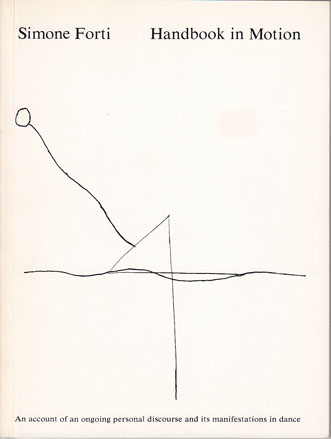Eadweard Muybridge: The Stanford Years 1872–82 (1972)
Filed under catalogue | Tags: · chronophotography, cinema, film, film history, movement, photography

Catalogue for the exhibition held at Stanford University Museum of Art in 1972.
Edited by Anita Ventura Mozley
Publisher Department of Art, Stanford University, 1972
136 pages
via Archive.org
PDF (60 MB, no OCR)
Comment (0)Simone Forti: Handbook in Motion (1974)
Filed under book | Tags: · choreography, dance, movement, performance

An account of an ongoing personal discourse and its manifestations in dance. Simone Forti is a dancer who has always forged her own path. She arrived in New York in the early 60’s from California. She brought with her a series of pieces that proved to be of serious influence on the development of “post modern” dance and sculpture in years to come. Her “dance-constructions” were based on a concern with bodies in action, the movement not being stylized or presented for its visual line but rather as a physical fact. The artist traces the development of her work intuitively rather than chronologically, including narratives about a time of participation in the drug culture that sheds light on the changes in her dancing. The book includes drawings, “dance reports” (short descriptions of events whose movement made a deep impression on the author’s memory), and documentary materials such as scores, descriptions, and photographic records of performances. Covers work from 1959 – 1973.
First published in 1974
Third edition, 1988
Publisher The Press of the Nova Scotia College of Art and Design, Halifax, Canada; with New York University Press, New York
Editor Kasper Koenig
ISBN 0937645052
152 pages
Gilles Deleuze: Cinema 1: The Movement-Image (1983–) [FR, ES, EN, RU]
Filed under book | Tags: · cinema, film, film theory, image, montage, movement, perception, philosophy

“First published in France in 1983, this is at once a revolutionary work in philosophy and a book about cinema. For Deleuze, philosophy cannot be a reflection of something else; philosophical concepts are, rather, the images of thought, to be understood on their own terms. Here he puts this view of philosophy to work in understanding the concepts—or images—of film.
Cinema, to Deleuze, is not a language that requires probing and interpretation, a search for hidden meanings; it can be understood directly, as a composition of images and signs, pre-verbal in nature. Thus he offers a powerful alternative to the psychoanalytic and semiological approaches that have dominated film studies.
Drawing upon Henri Bergson’s thesis on perception and C. S. Peirce’s classification of images and signs, Deleuze is able to put forth a new theory and taxonomy of the image, which he then applies to concrete examples from the work of a diverse group of filmmakers—Griffith, Eisenstein, Pasolini, Rohmer, Bresson, Dreyer, Stroheim, Buñuel, and many others. Because he finds movement to be the primary characteristic of cinema in the first half of the twentieth century, he devotes this first volume to that aspect of film. In the years since World War II, time has come to dominate film; that shift, and the signs and images associated with it, are addressed in Cinema 2: The Time-Image.”
Publisher Minuit, Paris, 1983
298 pages
English edition
Translated by Hugh Tomlinson and Barbara Habberjam
Publisher University of Minnesota Press, 1986
ISBN 0816613990, 0816614008
264 pages
Cinéma 1. L’Image-Mouvement (French, 1983; added 2015-7-17)
Estudios sobre cine 1: La imagen-movimiento (Spanish, trans. Irene Agoff, 1984)
Cinema 1: The Movement-Image (English, trans. Hugh Tomlinson and Barbara Habberjam, 1986)
Кино: Образ-движение (Russian, trans. Олег Аронсон, 2004, updated on 2013-9-26)
See also Volume 2
Comment (0)
